Santa Cruz
- Highlands of Santa Cruz
-
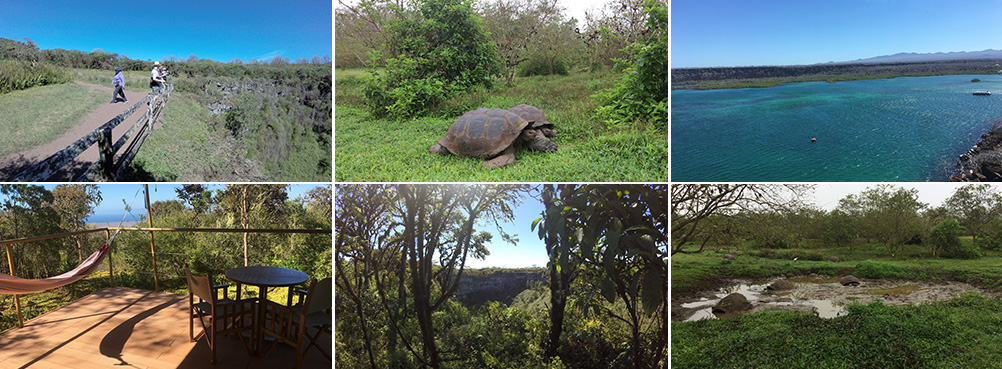
The first visit will be to Los Gemelos, there are pair of craters formed by collapse of the soil there is each in one side of the road. Also, you will have the opportunity to see the famous forest of Escalesia, an endemic plant of the Galapagos Islands and one of the favorites of the Finch birds. The next stop will be Las Primicias farm; it is an estate where the famous giant tortoises live in their natural habitat.
These tortoises prefer the high part of the islands since the climate is humid and there is plenty of food and water. Nearby there is the Lava Tunnels, long time ago these tunnels where rivers of lava.
- Bartolome Island
-
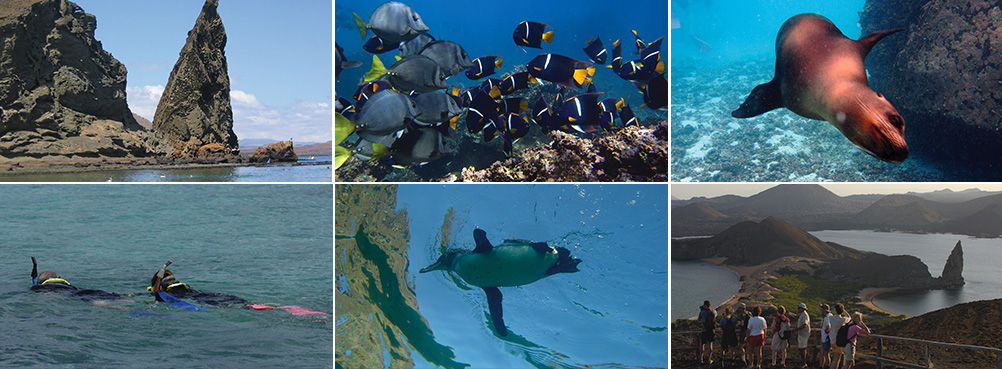
Bartolome is an island with a two hours boat ride.
Bartolome has a volcanic cone that is easy to climb and provides great views of the other islands. Bartolomé is famous for its Pinnacle Rock, which is the distinctive characteristic of this island, and the most representative landmark of the Galápagos.
It has two visitor sites. At the first one, one may swim and snorkel around Pinnacle Rock; the underwater world there is really impressive. Snorkelers are in the water with the penguins, marine turtles, white-tipped reef sharks, and other tropical fish. The bay is also an excellent place to go swimming. The twin bays are separated by a narrow isthmus.
Galápagos penguins are frequently seen, and a small cave behind Pinnacle Rock houses a breeding colony. Seasonally, Bartolomé is the mating and nesting site for the green turtles. With herons, they make use of the gentler beaches. The Galápagos lava cacti colonize the new lava fields.
- Santa Fe Island
-
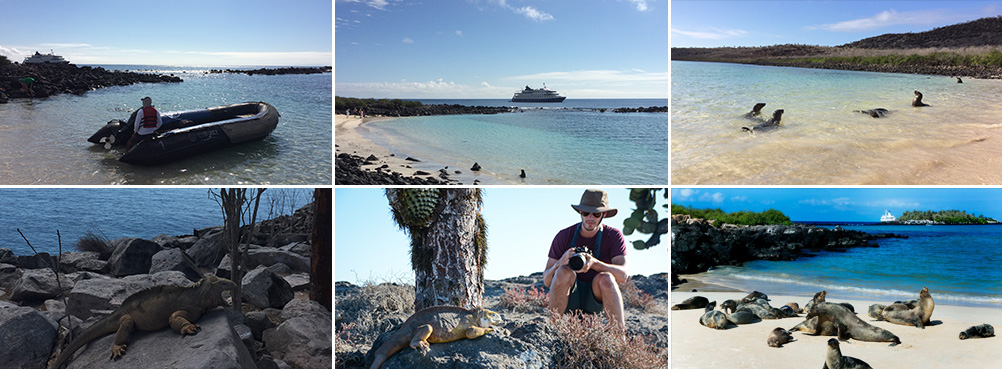
Santa Fe offers one of the more beautiful and sheltered coves in the islands. Its turquoise lagoon is protected by a peninsula of tiny islets forming an ideal anchorage. The island lies to the southeast of Santa Cruz within sight of Puerto Ayora. Like North Seymour, Santa Fe has been uplifted seismically, and you can see underwater lava formations.
A wet landing on a sandy white beach brings us into contact with one of the many sea lion harems. Bulls vie for the right of Beach Master, while smaller males mask as females to make stealthy mating moves. Galapagos hawks are often easily approached, perched atop salt bushes. The giant prickly pear cactus found here live up to their name, with tree-sized trunks!
Our goal is to spot one of the large species of land iguana native to Santa Fe. Beige to chocolate brown in color with dragon-like spines, these huge iguanas truly resemble dinosaurs. An indigenous species of rice rat also inhabits the thicket, and lucky hikers can spot harmless Galapagos snakes. After the hike, there is nothing more inviting than a swim in the calm waters of the bay.
- North Seymour & Bachas Beach
-
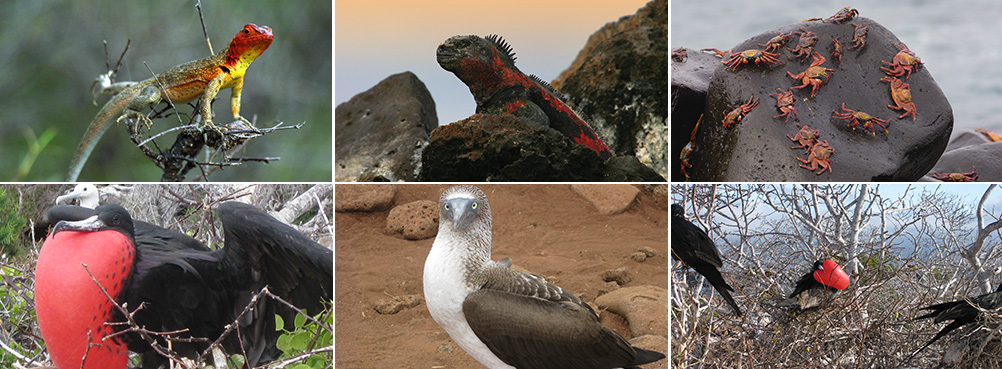
North Seymour, Island was lifted from the ocean floor by a seismic event, and its origins as a seabed give the island its low, flat profile. Cliffs only a few meters high form the shoreline, where swallow-tailed gulls sit perched in ledges. A tiny forest of silver-grey Palo Santo trees stand just above the landing, usually without leaves, waiting for the rain to bring them into bloom.
This island is teaming with life! You might have to give way to a passing sea lion or marine iguana; blue-footed booby nests sit beside the trail where mating pairs perform their courtship dance. Further along, the rocky shore displays white sand, and large flocks of pelicans mass for a dive-bomb feeding frenzy, rendering a tableau for us from ages long past. The trail turns inland to reveal the largest nesting site in the Galapagos of the “magnificent frigate bird.” These huge, dark acrobats have two-meter wingspans, and males, with puffed up scarlet throat sacks; sit precariously perched in low bushes to watch over their equally large chicks.
Las Bachas a sandy white-coral beach that is a major egg-laying site for sea turtles. On the shore, there are many marine iguanas and in the lagoon, flamingos are commonly seen. This beach is also a good place for swimming and snorkeling.
- Plazas Island & Punto Carrion
-
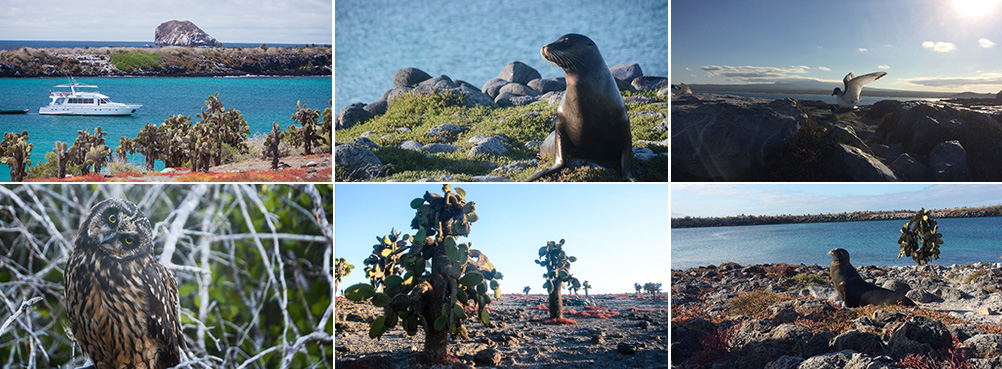
This is the southern partner of two small crescent-shaped islands that lie just a few hundred meters off the east coast of Santa Cruz. The northern island is used for scientific purposes only. South Plaza is one of the smallest yet richest islands in the archipelago. Only 130 meters wide (426 feet), it was formed from uplifted seabed, giving it a titled tabletop quality. Our landing is in the channel between North and South Plaza, where the island tilts toward the water.
The approach makes for a lavishly colorful sight! The turquoise waters of the channel contrast brilliantly with the white sand and black lava of the shoreline. The rocks have grown thick with green seaweed in places, speckled with bright orange “Sally light foot” crabs. Further up the shore a carpet of scarlet sesuvium succulents serves as groundcover for a grove of luminescent green prickly-pear cactus. Yellow-gray land iguanas sit beneath, waiting patiently for pears to drop.
The trail gradually follows the tilt of the island to the cliffs that overlook the ocean to the south, where swallow-tailed gulls nest. Red-billed tropic birds, masked and blue-footed boobies ride the windy currents. The overlook is a great place for spotting large marine life, including manta rays. Surf pounds an inlet at the western corner of the island, where a colony of sea lion bachelors make their home, accounting for the surface of the rocks, polished by the oils of their fur.
Your guide will find the right spot to snorkel, whether on Plazas Island or Punta Carrion:
The shoreline of Las Plazas makes for excellent snorkeling in a sea lion colony of nearly a thousand. Punta Carrion is a small bay where you can snorkel from the boat to see a variety of fish, rays and possibly white tip reef sharks.
- Bay Tour and Tortuga Bay
-
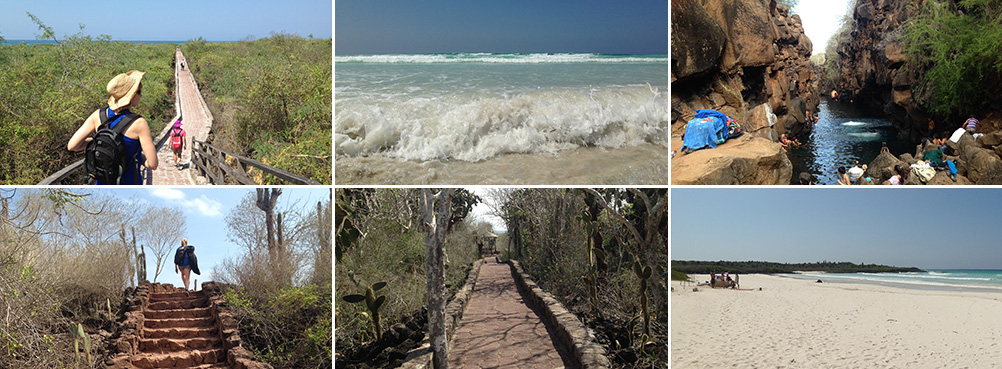 We take the dinghy over to “La Lobería”, in this tour you can snorkel and swim in transparent waters and play with friendly sea lions. Following the tour we headed to the "El canal Del Amor", a place where nature show us its beauty, at the end of this station, we are going to find a viewpoint where you can see white sharks. After a short hike you can see the marine iguanas in the "Playa de los Perros".
We take the dinghy over to “La Lobería”, in this tour you can snorkel and swim in transparent waters and play with friendly sea lions. Following the tour we headed to the "El canal Del Amor", a place where nature show us its beauty, at the end of this station, we are going to find a viewpoint where you can see white sharks. After a short hike you can see the marine iguanas in the "Playa de los Perros".“Las Grietas” is the last place that you are going to visit at this tour, is the Volcanic Rock pool located in Punta Estrada in this place you can swim and then we head back to the port.
Tortuga Bay is a beautiful white and powdery beach that seems to go on forever. Walking to the beach takes about 45 minutes at a leisurely pace.
Tortuga Bay is a nesting site for the black turtle. It’s one of the longest beaches of white sand, it is an ideal spot for surfing, snorkeling, swimming and walking. Visitors can appreciate in this place marine iguanas, sharks and sea turtles.
This island has a picturesque turquoise lagoon and calm waters where you can snorkel with sea Sharks. Also be able to see starfish, colorful fish and manta rays.
- Puerto Ayora & Charles Darwin Research Station
-
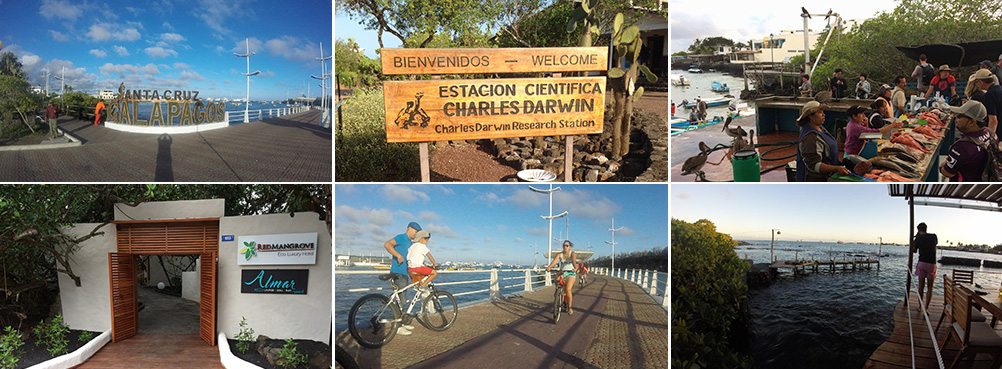
The Charles Darwin Foundation for the Galapagos Islands was founded in 1959, almost 60 years ago, under the auspices of UNESCO and the World Conservation Union.
The Charles Darwin Research Station www.darwinfoundation.org is the headquarters for The Foundation, in the Galapagos archipelago.
The mission of the Charles Darwin Foundation for the Galapagos Islands, and its Research Station is to provide knowledge and assistance through scientific research and complementary actions to ensure the conservation of the environment and biodiversity in the Galapagos Archipelago.
